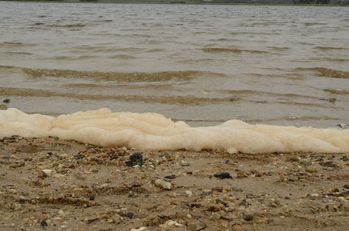 Guard Shore serves as a popular spot for local folks to unwind along the coast. It’s a secluded beach-like area with quiet rolling bay waves along the sandy shoreline, but have you ever wondered what all that foam that washes up is? It can spread along the coast in massive heaps or it’s sometimes just a light, bubbly layer over the sand. This mysterious foam is actually just a buildup of protein and other natural sea contents washed ashore. Commonly, decaying algal blooms create this thick sea foam. Large algal blooms decay in the water which will often find its way to the coast. However, the foam forms as the organic matter gets mixed up and moved by the current. You can see for yourself on a smaller scale how seafoam forms if you collected some ocean water in a jar and shook it up. Small bubbles would form on the top because you’d be stirring up all the contents found in the seawater, such as dissolved salts, proteins, dead algae and fats. You shaking up the jar would replicate what happens when the water gets moved by wind and waves. Don’t worry, the foam isn’t a danger to people or the environment. It’s actually a symbol of a productive marine ecosystem. Proteins, fats, salts and other organic matter are naturally found in seawater, plus the unnatural pollutants and artificial matter which can also contribute to the creation of sea foam, are what make the bubbles that can make some waves appear frothy. The waves hit the coast and the froth lingers behind which creates the piles of foam you may see on Guard Shore.
0 Comments
Leave a Reply. |
About
Everything you need to know about CBFS's educational programs, visiting Chincoteague Island, and more! Categories
All
Archives
January 2019
|
CHINCOTEAGUE BAY FIELD STATION | 34001 Mill Dam Road | Wallops Island, VA 23337 | (757) 824-5636 | [email protected]
 RSS Feed
RSS Feed

